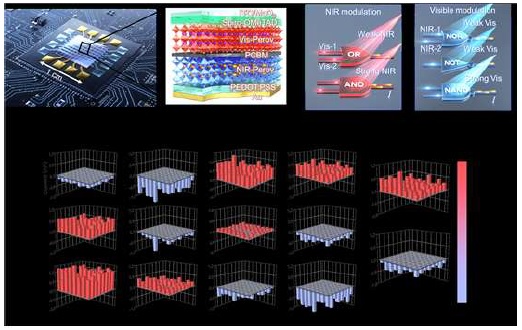2022-03-02
All 5 basic logic operations can be implemented with one optical-logic device
Recently, as artificial intelligence, self-driving cars, drones, and metaverse technologies are drawing attention as future growth industries, the demand for next-generation computers that can quickly calculate and process a lot of information is rapidly increasing.
logic device is a device or circuit that obtains an output value by applying one or more logic inputs to a certain logic operation (AND, OR, etc.). A logic circuit can be made mainly by combining a plurality of electronic transistors.
GIST (Gwangju Institute of Science and Technology, President Kiseon Kim) School of Materials Science and Engineering Professor Gun Young Jung's research team along with Dr. Yusin Pak's research team at the Sensor System Research Center at the Korea Institute of Science and Technology (KIST, President Seok-Jin Yoon) developed technology for optical-logic devices that operate with light using organic and inorganic perovskite* materials.
The research team focused on optical-logic devices that use light with low physical energy loss as an input signal. For this purpose, organic and inorganic perovskite that absorbs light to generate electricity was used. They succeeded in developing a stacked perovskite optical-logic device in which two types of perovskite thin films with different light absorption spectra are stacked like a sandwich.
It has been proven that the desired binary logic operation is possible by inputting two lights of different wavelengths and intensities. Optical-logic devices using light operate only with light energy without electricity, raising expectations for the development of power-free optical computer processor chips. Logic operation is an operation applied to one or two binary numbers and refers to a system that derives a result value according to a set rule.
Existing logic devices can only perform one logic operation, but the perovskite optical-logic device developed by the research team can perform and implement five different basic logic operations with one device: AND, OR, NAND, NOR, and NOT.

Schematic diagram of a perovskite optical-logic device and logical operation result of OR, AND, NAND, NOR, NOT
GIST Professor Gun Young Jung said, "The optical-logic device developed through this research is a splendid achievement of optical computing R&D that implements five basic logic operations into one device, and this should greatly contribute to the R&D of next-generation optical communication, optical network, and healthcare."
KIST Dr. Yusin Pak said, "Perovskite optical-logic devices that input light and output electrical signals will provide an important milestone in R&D for optical processors and are expected to be used in ultra-small and low-power optical sensor platforms in the future."
This research was supported by the National Research Foundation's Mid-level Researcher Support Project and KIST's Institutional Project (Quantum Sensing Source Technology Development) and was published online on February 7, 2022, in Nature Communications, a top journal in science and technology.

GIST Professor Gun Young Jung
* organic and inorganic perovskite: ABX3 opto-semiconductor material with perovskite crystal structure has the ability to absorb light to create electrical energy, and it is being actively researched as a core material for optical devices such as solar cells, optical sensors, and LEDs.













